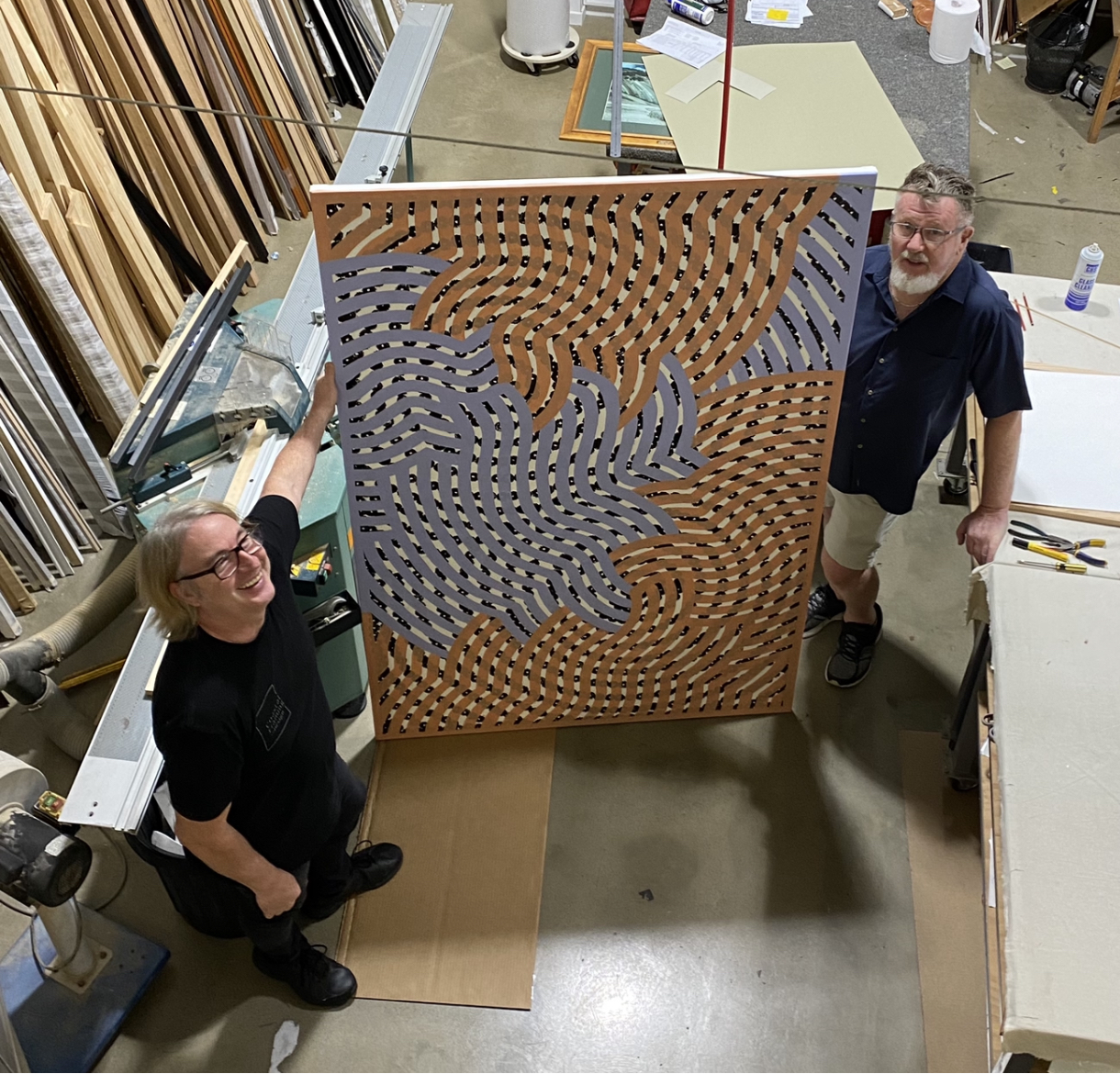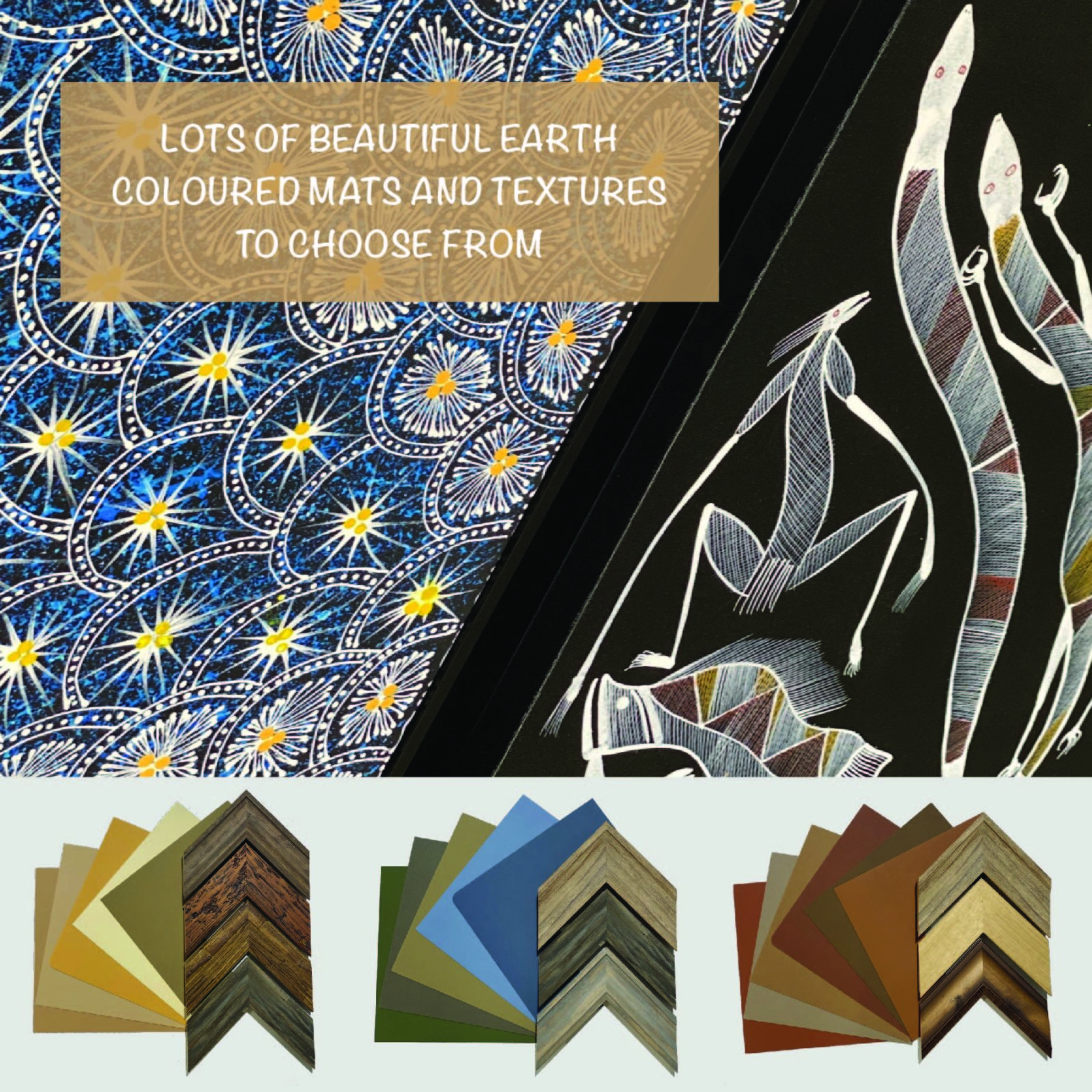At Coastal Framing and Design, we specialise in framing Indigenous art of all types and styles.
WHAT IS ABORIGINAL ART WORK?

ABORIGINAL ART HAS BECOME A VERY POPULAR ADDITION TO THE HOME
FRAMING ABORIGINAL ART
Over the last year or so as people travel closer to home, we have enjoyed framing a large range of aboriginal artwork. The stories of both the traveller and the art have made for interesting days around the framing table and in the workshop. You know when an art work is authentic, you can smell the smoke, earth and sky in it.
Types of Aboriginal Art
Indigenous artwork comes on many mediums, such as paper, natural bark and textiles. The most common varieties that come across our framing table are:
- Rolled, flat canvas or quality Belgium linen with the art medium being acrylic paint.
- Art works on paper.
Styles of art work
Across each area of Australia, you will find different styles of art representing the dreaming of each cultural group of people. Not all Aboriginal art is Dot art work.
Cross-hatching (Rarrk) design and x-ray paintings come from the Northern Territory and in particular Arnhem Land.
Central Australian paintings take on a more abstract style, originating from sacred designs used in ceremonies. Dot paintings created with sticks, round objects are typical of this area.
Wandjinas

Wandjinas are only found in the Kimberley region (north-eastern Western Australia); they aren’t seen anywhere else in Australia.
There is much to learn about indigenous art. Artlandish is a great source for information. https://www.aboriginal-art-australia.com/aboriginal-art-library/aboriginal-art-styles/
So how do you frame an Aboriginal Art work?
There are many opinions as to how aboriginal artwork should be framed. It depends on how you want it to look and most importantly, if it’s an authentic, valuable piece, how to preserve it as well as making it look fabulous on your wall. If you have a certificate of authenticity, we need to conserve the value of the artwork, as this is considered a ‘collectors’ piece. However, the most important thing is that you celebrate and enjoy the artwork and its story on your wall.
It can be:
Stretched over pine stretcher bars and left open at the back
Stretched over pine stretcher bars with a stylish, float frame added for strength and a more ‘dressed’ look
Framed under glass with or without mat boards
Mounted down for a smooth finish, or kept in it’s natural state Z mounted under a matting board to give a decorative look.
Rolled Canvas or Linen
The best way to preserve the value of your canvas work is to have it stretched over quality, timber stretcher bars. These have specialty raised edges so that the canvas does not sit directly on the timber, hence preventing acids from the wood leaching into the canvas. These stretched canvases can be ‘un stretched” and at a later date, be flattened out into their original state.
For large canvases, a timber brace may be required through the middle of the piece to add support and prevent warping.
There’s no need for glass as the natural canvas with acrylic paint should not fade. The detail and texture will remain visible and touchable and even ‘smellable’ in an authentic, earthy way.
The edges of your canvas when it’s stretched may be jagged, uneven and tatty. To add style and support to your aboriginal art, you can select a float frame. This is the L shape frame that the stretched canvas is dropped into. The frame sits on the side of the canvas giving support and a décor finish, with a thin shadow line at the front. It basically neatens up the sides.

Add a float frame, or shadow box.
When framing Aboriginal art, always look for options such as natural products such as oak or blackwood as they offer raw and authentic products. Black and browns are also popular as they often mirror the colours in the art work.
This can be finished with a foam core backing and framer’s tape which protects against moisture seeping into the canvas at the back.
An authentic aboriginal canvas art is often not “square”. If it’s not square to start with, it won’t usually be squared up when it’s framed. It is what it is. The pattern may be uneven on the sides. That’s the sign of a handprinted authentic piece of art.

This art work by Jeannie Daniels has been stretched onto stretcher bars and framed with a natural oak ‘float frame. ”
Protecting your canvas in humid climate can be an option
I have an authentic, aboriginal canvas that I purchased from Aboriginal Artist, (the late) Thelma McLean along the Great Central Desert Road. I’ve protected it from the elements here on the coast. Rex stretched it onto stretcher bars, then we added a deep, box frame. By doing this, you have the rebate on the frame to then add a sheet of quality perspex as a covering. By adding a foam backing and sealing the work up well with framing tape, the canvas is protected against mould, air, moisture, insects and light. I’m thinking of taking it apart and reframing the canvas again with a float frame, leaving the front in the natural state. With air conditioning and out of harsh light, the canvas will keep better in an airy environment.
Framing under glass
Many clients like to have their aboriginal art protected and displayed under glass.
This is an option that, when done correctly by professionals, can retain the value of the art, however, it is important to not stick or mount the canvas or paperwork down if you are conserving it’s value as a collectable piece.
Select an acid free matboard, such as cotton rag, to add style and keep the glass from touching the art work. The art can be hinged or taped under the matting. This allows the art to hang freely.
Select earthy mat boards and frames to highlight your art work and finally select the glass of your choice. The ideal glass is Ultra View clarity glass, UV conservation clear or Perspex.
Taped backings of foam core are necessary to keep mould and moisture away from the inside of your frame.
With Ultra View glass, Museum glass or Optimum Museum acrylic, your aboriginal art will appear glass free and be protected for many years.

Mount the canvas down for a super smooth, arty look.
In some instances, if the value of the art is not great the canvas can be mounted onto a substrate in our heat mounted press. This may be reversable depending on the medium. Framing Aboriginal art in this way is particularly great if you have an old, tatty or a creased paper or canvas work that you need brought back to life. The result is amazing as the frame and glass is added for a super cool look.
Learn more about custom framing here: www.coastalframinganddesign.com/custom
Where can I purchase authentic aboriginal art?
My personal favourites that I have visited:
If you’re looking for a drive to the Hinterland, travel to Bangalow and check out Ninbella Gallery
Here you will find a range of contemporary, ethical and sustainable aboriginal art. These guys are a member of the Fair Trade Association of Aboriginal art.
If you’re heading for the Kimberley, and in particular Katherine, visit this Top End Gallery which is 100% aboriginal community owned.
Here you can purchase authentic aboriginal art https://mimiarts.com/about/
They can also sell to you online and deliver it to you at your home.
Leshell McLean carries on the traditional art work of her Grandmother, Thelma McLean whose art work we bought along the Central Desert Road. https://papulankutja.com.au/artists/
If you would like to learn more about the patterns and symbols of Aboriginal art work, check it out here.
Learn more about Aboriginal art and the symbolism
Make your appointment with us now and bring your aboriginal art work in for framing.
Enjoy
Jen
